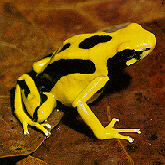Toxin Introduction
|
What is a toxin?
Toxin (täks'in) n. 1. any of various poisons produced by microorganisms and causing certain diseases 2. any poison secreted by plants or animals (Agnes 1996). Toxins-Poisons (usually proteins) produced by living organisms, especially those capable of stimulating the production of antibodies (Art 1993). |
||
|
Prior to understanding what kind of toxins are found in Poison Dart Frogs, it is important to understand what a toxin is. The definitions above begin to give a clue as to what they are and how they work. While all Poison Dart Frogs are indeed poisonous, only a few pose serious threats to humans (Patocka et al. 1999). In total this group of animals numerous classes and types of toxins have been ellucidated and in reality, scientists are only beginning to understand the incredible dynamics behind frog toxins. In total over 500 different alkaloids separated into 20 different structural classes have been found in frog and toad skin extracts (Daly et al. 2000). Among the classes of toxins are the famously potent Batrachotoxins along with Pumiliotoxins, Histrionicotoxins, and Epibatidine. All of these toxins play an integral role in the physical defense of Dendrobatid frogs from potential predators. |
Photo courtesy of Dirk Huppert. |
|
|
Photo courtesy of Jimmi Pedersen. |
Are all toxins in Poison Dart Frogs the same? Simple answer...most assuredly no! While all toxins in dendrobatid frogs play a role in physical defense, the way they do so is varied. The toxins in Dendrobatid secretions have a variety of intensities ranging from hightly toxic to relatively mild in nature. The strength of the toxins have even been known to vary across different populations of the same species (Daly et al. 1980). Furthermore, the diversity continues as over 100 different types of toxins have been found within the Dendrobatids alone (Daly et al. 1980). As we shall soon see the structures and chemical properties of these toxins are quite varied as well. Once again Poison Dart Frogs show their varied and unique natural ecology. |


